Archive for category April 2017
Ignore Public Criticism? Sometimes, Yes.
Posted by admin in April 2017, Past issues on April 2, 2017
By K S Venkataraman
I heard this story by Sivakumar Ayya on Tirumandiram, a canonical work on Saiva Siddhantam in Tamil with 3000 four-line terse verses, many of them in what is called Sandhya bhasha with words having esoteric and hidden meanings. This makes it impossible to translate many of the verses into comprehensible English. You need a good commentator such as Sivakumar Ayya to explain the import of the verses.
In any case, this is his advice on the need for us to develop indifference to public criticism when we are trying to do something good:
There was a rich man in a village. After experiencing everything life offered him, he saw the futility of all his worldly pursuits. So, he gave up all his wealth and became a mendicant.
As a mendicant, he was lying down on the floor on a roadside public place using bricks as a pillow. Two local village women passing by recognized him. They were talking: “Look, this man was rich. He left everything and became a sannyasi. See how he is now lying on the floor!â€
Her companion commented: “Uh! If he is really a sannyasi, why does he need bricks as a headrest for sleeping?â€
The mendicant was listening. Seeing their point, he removed the bricks he was using as pillows and was trying to fall asleep.
The two women were returning after their errands. Seeing that the mendicant was sleeping without even the brick as his headrest, the first woman told her friend: “See, he heard your comment and is sleeping without the headrest. He is indeed a true sannyasi.â€
Her cynical companion commented: “What sannyasi is he, trying to overhear the conversation between two women?â€Â   ♣
Obituaries: Jagbir Singh Bedi (1946 to 2016) and Indu Bedi (1948 to 2016)
Posted by admin in April 2017, Past issues on April 2, 2017
They struggled to survive with their catering skills
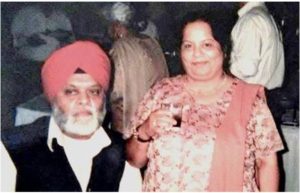
Jagbir Singh and Indu Bedi
On December 23 last year, Jagbir Singh Bedi died in Pittsburgh; and just one week after his death, Indu Bedi, his wife and life partner for 45-plus years through the thick and thin of his life, also passed away. Heart problems were the causes for their deaths.
Jagbir Singh was a Partition baby, born in Gujranwala (in Pakistan today). His parents came to India after the Partition. Indu was born in Amritsar, Punjab. Jagbir Singh owned a business in India before they migrated to the US in 1984, landing in Pittsburgh.
In Pittsburgh, Jagbir Singh used his natural entrepreneurial instincts to start businesses in Indian groceries (Home Fair) and restaurants (Vegetarian Delight and Durbar). However, the businesses did not last. The Bedis stoically bore their disappointments, accepting them as part of life. They tried to stand on their own feet by servicing the catering needs of Indians in the Tri-State area.
About ten years ago I once saw him when he was in his early 60s working with his wife in their catering kitchen in Monroeville. They were sweating it out in the mid-August heat in front of a large kadai (wok) deep-frying samosas and making chicken and lamb items for his clients.
Jagbir Singh had a wry sense of humor. Laughingly he once recalled his experience selling his restaurant to Indians who had no experience in the restaurant business. “Do you know they had twelve partners? Can you imagine running a restaurant with twelve partners?†Laughingly he continued: “I am having difficulty running this place with my family!â€
The Bedis leave behind two sons and a daughter. Gagan is in India and Sandeep is in Pittsburgh. Their daughter Poonam lives in Houston, TX; Jagbir’s brother Datar Singh and his family and his nephews and nieces live in Pittsburgh.
The Bedis were cremated in Pittsburgh following the Sikh rites.
— By Kollengode S Venkataraman  ♣
Obituary: Suman Ahuja, (Jan 17, 1947 – Feb 1, 2017)
Posted by admin in April 2017, Past issues on April 2, 2017
A Well-liked Psychiatrist
S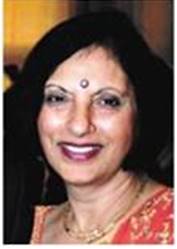 uman Ahuja, a retired psychiatrist from the V. A. Medical Center and a longtime resident of Pittsburgh, died on February 1, 2017.
uman Ahuja, a retired psychiatrist from the V. A. Medical Center and a longtime resident of Pittsburgh, died on February 1, 2017.
She was born on January 17, 1947 in Chiniot, Punjab (in Pakistan today). She was the youngest in a family of six, of four brothers and two sisters.
She had her schooling in Delhi and earned her medical degree from Gauhati Medical College in Assam. She met her husband Subash in New Delhi in 1974, married and joined him in New York that same year. After finishing their residencies in New York — she in psychiatry and he in pathology — they moved to Pittsburgh in 1977. She joined the V.A. Medical Center as a clinical psychiatrist, where she worked for over thirty years.
They raised two lovely children, Rajiv, born in Brooklyn, N.Y. and Nina, born in Pittsburgh, PA. She was grandma “Bima†to two adorable grandchildren, Riaan, 5 and Rayna Lakshmi, 1. With her two children settled in their careers, Rajiv, a lawyer, in practice in the field of Health Care Management, and Nina, a physician, pursuing a fellowship in Gastroenterology, and her own successful career in the field of Psychiatry, she was happy and content with her life.
She was a very caring person, always helping others. She volunteered in the soup kitchens and was on the Humanitarian Committee at Hindu Jain Temple. It was not money or fame that she sought, but a loving family and close friends she yearned for. She was successful in her goals.
She loved dancing, cooking and entertaining, enjoyed music and listening to soothing Bhajans, and Ghazals & Shayries (Hindi/Urdu poetry recitations).
Although, she was very conscious of her health and practiced daily yoga and meditation, she developed an autoimmune liver disorder towards the later part of her life. With her deep faith in God, she always maintained a cheerful and positive outlook.
Suman leaves behind Subash, her husband of 43 years, two children, two grandchildren, and three siblings in India. She was cremated with Hindu Vedic rites on February 4, 2017 in Pittsburgh.
— By Praful Desai, Greensburg, PA  ♣
On the Impoverishment of Servitude
Posted by admin in April 2017, Past issues on April 2, 2017
By Kollengode S Venkataraman
Tiru-mangai-alvaar, a Bhakti Tamil poet, is one of the twelve savants in the Vaishnava tradition in the Tamil country. He composed several hundred verses (part of the compendium called Divya Prabandham containing nearly 4000 verses) addressing Vaishnava deities in his pilgrimage. Analogously, the works of several Tamil Saiva poets (between the 6th and 9th centuries) called Tevaram and Tiruvachagam, and others are over 8000 verses in different meters.
Literary critics date Tiru-mangai-alvaar between the 7th and 9th centuries. In one of his verses* he candidly pours out his personal inadequacies that resonate even today in our “modern†times. Here is his verse addressed to Venkateswara of Tirupati in India:

Here is the free-style non-poetical translation of the verse:
Unknowingly, in my youth, I indulged in countless bad deeds!
As an adult, laboring for others, I became impoverished!
O, Hari, the Lord of the Venkata Hills with surrounding forests
      where elephants roam,
Here I am! Accept me [with all my faults] and grant me your grace!
We work in our jobs as employees, professionals, or as entrepreneurs and accumulate wealth of various kinds. But the poet here poignantly confesses that he was impoverished working for others. Is this not strange? We may never know who he worked for or the nature of his earnings over 1200 years ago. It is entirely possible that he, like us today, was not content with his earnings. Greed is so simple: no matter how much we earn and accumulate, often, we wish for more. But not getting more than what we actually get does not make us impoverished. So, why does the Alvaar confess, “I became ‘impoverished’ laboring for others?â€
The Alvar’s impoverishment probably was not material. Most likely, his was the spiritual impoverishment he suffered in earning his living — like the excessive servitude he showed to his employer. Or committing acts he should not have, or deliberately omitting acts he should have carried out, and making all kinds of unethical compromises along the way. In today’s parlance, it is like indulging in unethical practices to get ahead of others — even outright cheating and lying. Or by our becoming silent accomplices in the unethical business practices in work places, even in temples.
Such frustrations as in the confession above have been the bane of human existence. Here is another example: Pattinattaar, a Saiva mendicant in the 10th century Tamil Country, expresses the humiliation people endure when they go to rich and powerful people seeking favors. Incidentally, Pattinattaar was not born to poverty. He was a prosperous trader. He became a mendicant out of choice. A dramatic transformation occurred in his life when he realized, “Not even an ‘eye-less needle’ is of any help during our final exit.â€Â Here is his original expression in Tamil
![]() Sewing needles are of value and use only so long as they have the “eye.†Once the “eye†of the needle breaks off, the eye-less needle has no value whatsoever. Realizing this, Pattinattaar walked away from his wealth, becoming a wandering mendicant. He composed priceless poems on the human predicament in various situations using humor, cynicism, anger, irony or sarcasm in his expressions. People memorize these rhyming, alliterating verses even today.
Sewing needles are of value and use only so long as they have the “eye.†Once the “eye†of the needle breaks off, the eye-less needle has no value whatsoever. Realizing this, Pattinattaar walked away from his wealth, becoming a wandering mendicant. He composed priceless poems on the human predicament in various situations using humor, cynicism, anger, irony or sarcasm in his expressions. People memorize these rhyming, alliterating verses even today.
In one verse Pattinattaar puts his frustrations pretty bluntly in an alliterative and rhyming verse addressed to Shiva in Mount Kailasa:

Translation:
O, my father, the Lord of Mount Kailasa, when will be the dayÂ
    when I don’t have to go behind the rich, whining about my problemsÂ
    seeking favors by ingratiating myself with them and fawning over them?
And when will I be free from this misery, and experienceÂ
    the bliss of being content with myself in solitude?
On the human yearnings for a higher call, every Indian language is a treasure trove of verses like the ones presented here. I say this with my sketchy understanding of Hindi/Bhojpuri/Awadhi Bhajans, Kannada Devaranamas and Vachanas, and after listening to pravachans on the shabads from the Adi Granth at the Gurudwara.
Unfortunately, in today’s India with the overemphasis on the anglicized education by rote, regional languages (including one’s own mother tongue) are losing their influence on youngsters. And nobody knows how to stem this tide. And there is only minuscule interest among India’s youngsters in one region to learn another Indian language. What is even worse is people’s benign condescension or outright hatred for other regional languages. This is a great Indian tragedy unfolding in front of the whole nation that nobody seems to recognize — or care, even when they recognize it. ♣
* I acknowledge Kalyani Raghavan of Edwewood, PA for the exact reference to this verse.  ♣
Some Protest Placards Make Us Look at Life Differently
Posted by admin in April 2017, Past issues on April 2, 2017
K. S. Venkataraman
A good protest placard conveys complex social issues in a simple and direct language. This placard is an example.
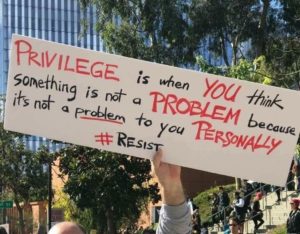 Take the example of today’s working class families with below-the-median family-income of ~$55,000 a year. They try to stretch their limited resources to meet their needs for paying their bills on time, saving for their future, and educating their children.
Take the example of today’s working class families with below-the-median family-income of ~$55,000 a year. They try to stretch their limited resources to meet their needs for paying their bills on time, saving for their future, and educating their children.
When allocating their limited monies for different needs, even suboptimal decisions have huge consequences. This is true in educating children. Not getting proper guidance at crucial stages in their high schools often make these kids to go unprepared to the rigors of university education.
With their limited resources, it will be difficult for these kids to make a course correction in their education when they realize that they took a wrong path when facing a fork in their education journey.
Families living above $100,000 dollars of income/year tend to be better educated and informed about the way of the world. They give better guidance to their kids. Further, children from these families have the luxury of time and resources to change their education options even after their first degree. The higher the family income and resources, the greater is the leeway for children in this. This is a simple fact of life.
Parents from higher income families are aware of this. But they try to camouflage this by attributing all their children’s accomplishments to their intelligence and hard work — on their DNA and the family memes. “We are a better breed,†they subconsciously would want to believe.
The DNAs and memes are very important factors, no doubt. However, many other factors — protracted illnesses, deaths, divorces, job losses for parents, political turmoils, for examples — over which the parents and their kids have no influence or control, have a big say in what we accomplish in our lives.
So, when I read the placard again, I feel a sense of gratitude for all the help and generosity I received at critical junctures in life — and a sense of obligation to society at large.   ♣
Obituary:Â Â Mohinder Mohan Bahl (1938 – 2017)
Posted by admin in April 2017, Past issues on April 2, 2017
A Respected Doctor in Internal Medicine
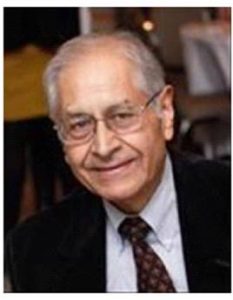 Dr. Mohinder Mohan Bahl, a longtime resident of Pittsburgh, passed away on February 3rd, 2017. The cause of his death was complications following a stroke in his long battle with heart problems.
Dr. Mohinder Mohan Bahl, a longtime resident of Pittsburgh, passed away on February 3rd, 2017. The cause of his death was complications following a stroke in his long battle with heart problems.
He worked at the Shadyside Hospital and the East Suburban Hospital in Monroeville (now Forbes), while also mentoring many young doctors. His specialty was internal medicine. Loved by his patients and respected by his peers, he was recognized by the Allegheny County Medical Society for his years of distinguished service.
Bahl was born in 1938 in Nairobi, Kenya.  He was the third among his five other siblings. He earned his medical degree in India on a scholarship. He came to the US in 1972, pursuing his American dream. He did his residency in internal medicine in Pittsburgh and other places in the US. In 1975 he opened his medical practice in Penn Hills where he served his community for over thirty-five years with diligence, dedication, and kind disposition.
While working as a doctor in Nairobi, in 1964 he married Saroj. The Bahls with their three young children came to the US in 1972. In the early days of Indians coming to live in Pittsburgh, Mohinder Bahl was active in the Indian community. He was a founding member of the Hindu Jain temple. He gave his full support to Saroj’s dedicated efforts to add the Indian Nationality Room in the University of Pittsburgh’s Cathedral of Learning. The Indian Nationality Room, against many odds, was dedicated in 2000. He supported many charitable organizations locally and abroad including the Red Cross and Ekal Vidyalaya, which builds schools in rural, interior India.
Mohinder Bahl was always dignified and gracious with people. He had a good sense of humor that his children imbibed from him. He liked gardening, current events, discussing politics, and he avidly collected coins.
He leaves behind Saroj, his dear wife of fifty-two years of marriage; his three sons Ashish, Monish and Sachin and their wives; his only daughter Mala and her husband; and his ten grandchildren, whom he adored. His brother Vijay Bahl lives in Pittsburgh.
His cremation ceremonies followed Vedic rites at the Beinhauer Funeral Home on Sunday, February 5.
—  By Nita Wadhwani, Presto, PAÂ
Ramalingam Sarma: Celebrating 100 Years
Posted by admin in April 2017, Past issues on April 2, 2017
Translated Valmiki’s Sundarakaandam into English in his 80s
By Jayashree Phanse
e-mail: jphanse560@hotmail.com
February 12, 2017. Venue: A modestly decorated Banquet Hall at the Cascade Marriott in Dallas for 150 people. With children running around, adults were chatting, munching on hot samosas and pakodas and sipping Lassi or Chai. We were awaiting the arrival of Shri Ramalingam Sarma, our hero, to celebrate his 100th birthday. Ramalingam Mama — mama is an endearing term for maternal uncle in Indian languages — alert as ever, arrives in a wheelchair with his sons, daughters, and grandkids in tow. He lives in Dallas with his son Arvind. People greet him with bouquets and pranams. Mama calls out one of the guests, “Govindraj, so you made it. Look, I am wearing the shirt you bought for me!!â€
As Chaitanya, Mama’s grandson, gets ready to welcome everyone, Mama interrupts, “It is just another birthday and it happens to be 100. I welcome you all for my 100th birthday,†and blesses in Sanskrit: “Jeevet sharadah shatam†— ‘May you all live for 100 autumns.’ He continues with a smile, “And invite me for your celebrations.â€
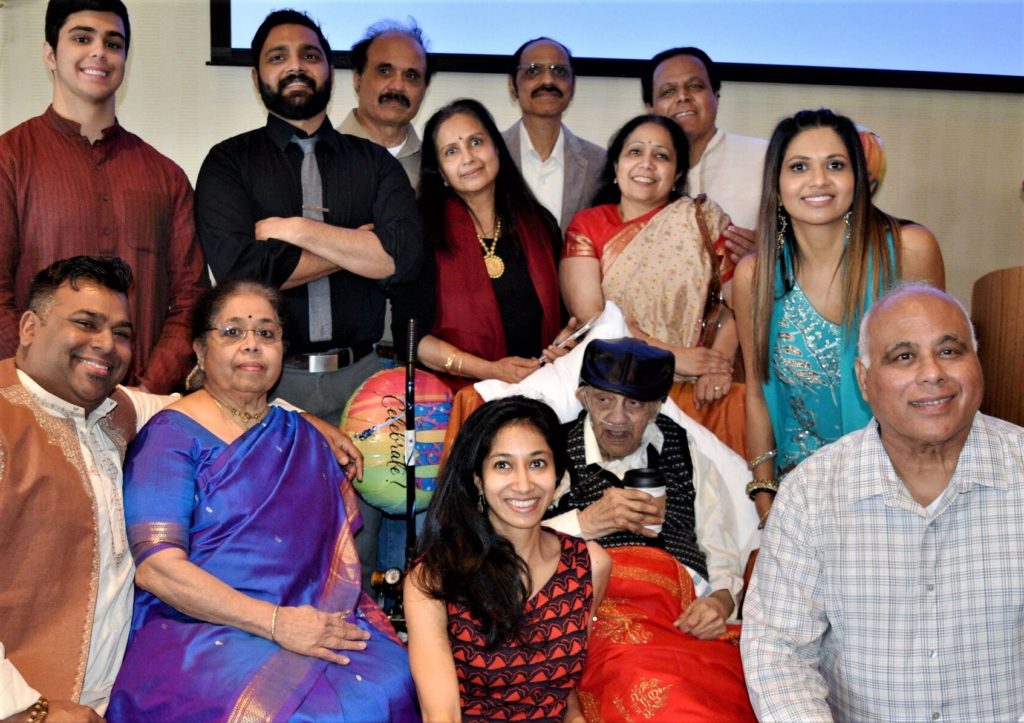
Geetha Manian, Shri Sarma’s daughter, is in the blue sari.
Mama has a Pittsburgh connection. With his wife Shakuntala (now deceased) he visited the US in 1984 for his son Arvind’s wedding. After retirement, they migrated to the US in 1988 since all their children were here. He lived in Pittsburgh with his daughter Geetha Manian until 2005 to help her raise her son as a single mom. Geetha still lives in Pittsburgh. Many here remember him as an energetic, wiry, alert man.
Mama had studied basic Sanskrit during his school and college days. This was eight decades ago. “Like many
youngsters, in my youth I was not interested in understanding Sanskrit chanting done during routine worships,†he says. After he turned 80, he started refreshing himself in the language’s arcane grammar with books and help from the Internet.
In his boyhood, he had listened to his mother reciting in Tamil Sundarakaandam, a section in Ramayanam. Later he read it in Tamil. Valmiki’s Sanskrit original has 2800 slokas (verses) in 68 sargas (chapters). He wanted an English translation to be useful for today’s youngsters with these features: It should go beyond the simple translation. He set himself for this big task while he was in his 80s. He wanted to present each sloka in the Devanagari script as in the Valmiki’s original with these features added: Classical Sanskrit slokas are with complex Sandhi rules (coalescence of vowels and consonants) and meters peculiar to the language. So, each sloka is simplified in the Devanagari script by breaking the coalesced phrases into simpler words with meanings for easy reading and understanding. Transliterating this into the Roman script, Sarma gives the translation of the verse in English.
For doing this, Mama, while in his 80s, learned computer skills and the necessary software for transliteration from the Roman to Devanagari scripts.
This enormous task took eleven years for completion, with Gargi (Mama’s youngest daughter) and her husband
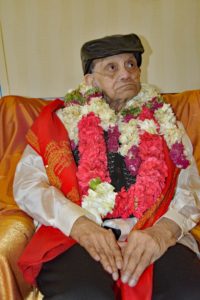
Mama Shri Ramalingam Sarma at his Centenary Celebrations.
Chandrakant helping him in the last two years. Sujatha Awathi, a Sanskrit professor in Pune, proofread the work and helped in getting the work printed in two volumes of more than 600 pages each. Two-hundred-and-fifty copies were printed in Pune, and several were donated to various universities.
Many assembled in the centenary gala recited poems and prayers, and sought Mama’s blessings by doing pranams to the centenarian. Mama’s sons, daughters, and grandchildren put together a slide show with occasional commentaries by Mama himself! The guests were given a coffee mug with the famous Rig Veda phrase Aano bhadraah kratavo yantu vishvatah printed. The phrase literally means “Let noble thoughts come to us from all directions.†Incidentally, this is the first Sanskrit lesson I learned from my father when I was less than 10 years old.
In his 100th year, Mama sent individual and personal “Thank you†emails using his i-Pad for those present at his 100th birthday bash.
Even at 100, Mama is fully independent, with the need for occasional oxygen supplements. He is mentally alert, and his memory is as sharp as it can be. Evidently, the good genes he inherited from his parents have played a big part. However, we also need to recognize the other lifestyle choices he made: All through the one hundred years of his life, Mama has been disciplined and simple in his personal life, even as he lived through several difficult transitions; fastidious and frugal in his eating habits; regular in his exercise routines; and attentive to his health. He is a good role model for us on this. We wish him well.   ♣
Harish Saluja’s Miniature Paintings Exhibited
Posted by admin in April 2017, Past issues on April 2, 2017
By K. S. Venkataraman
Taking inspiration from Rajasthan’s rich tradition in miniature paintings, our multi-faceted Harish Saluja used his palette and paint brushes to create bright paintings using water color, acrylics and other materials. His medium for these miniature paintings are 3†x 5†index cards, with abstract and Asian motifs.
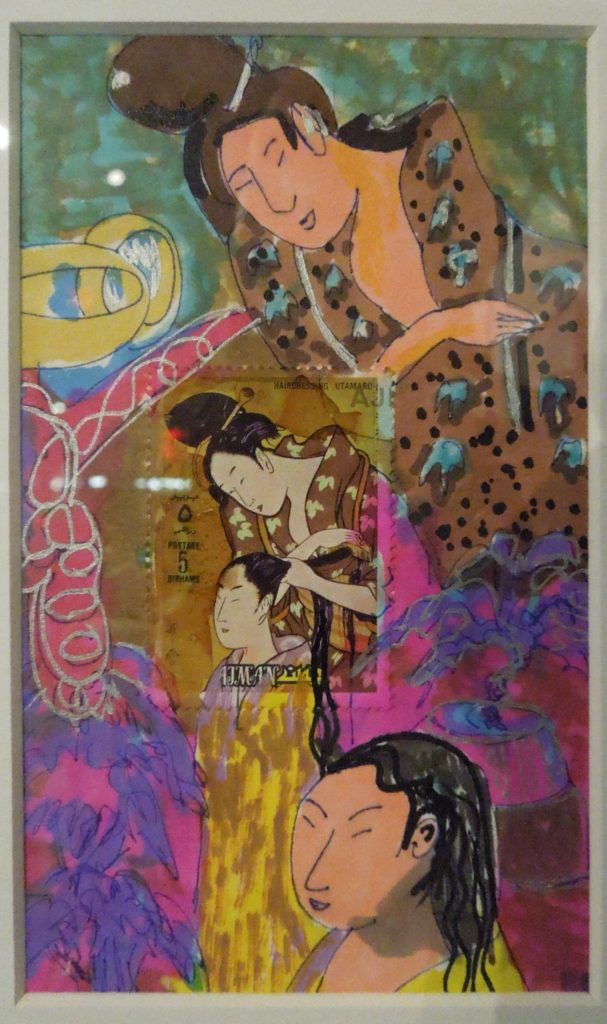
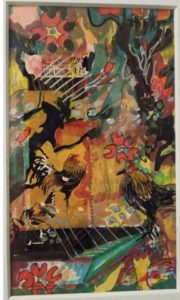 Over 100 paintings were on display during February-March in a gallery on Liberty Avenue. Arts aficionados, Saluja’s friends and well-wishers, including Pittsburgh Mayor Bill Peduto (see below), were there on the opening day to hear Saluja sharing his inspiration for these paintings.
Over 100 paintings were on display during February-March in a gallery on Liberty Avenue. Arts aficionados, Saluja’s friends and well-wishers, including Pittsburgh Mayor Bill Peduto (see below), were there on the opening day to hear Saluja sharing his inspiration for these paintings.
The adjacent picture measuring 3†x 5†is the actual size of the paintings displayed.
Harish says he had no formal training in arts schools; or for that matter in music or film making, for which also he is known. His talents are natural, like the fragrance of flowers in the wild.  ♣
Obituary: Sarjit Singh (Nov 1, 1939 to Dec 22, 2016)
Posted by admin in April 2017, Past issues on April 2, 2017
Well-liked Neurologist, Founding Member of AAPI and the Pittsburgh Sikh Gurudwara
Dr. Sarjit Singh, a long-time resident of Weirton, WV, passed away peacefully at his home on Thursday, December 22, 2016. He was 77. The Greater Pittsburgh Area has lost one of its outstanding members.
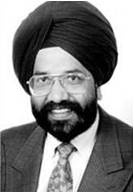 Born in Tanda, Hoshiarpur district in Punjab, India, Dr. Singh obtained his medical degree from Glancy Medical College, Amritsar, Punjab. He came to the United States in 1969 with his wife, Dr. Ranjeet Singh, now a retired pathologist. He trained in neurology in Buffalo, New York, and completed a clinical fellowship at Harvard University.  In 1975, the Singhs settled down in Weirton.
Born in Tanda, Hoshiarpur district in Punjab, India, Dr. Singh obtained his medical degree from Glancy Medical College, Amritsar, Punjab. He came to the United States in 1969 with his wife, Dr. Ranjeet Singh, now a retired pathologist. He trained in neurology in Buffalo, New York, and completed a clinical fellowship at Harvard University.  In 1975, the Singhs settled down in Weirton.
Dr. Singh was an assistant clinical professor of neurology at the University of Pittsburgh Medical Center and the Medical College of Pennsylvania. Dr. Singh actively practiced neurology up to the time of his death. He authored numerous research papers in neurology. His patients liked him for his clinical skills, compassion, personal attention, and cheerful disposition.
Dr. Singh was a founding member of AAPI, the American Association of Physicians of Indian Origin, where he also served as president in 1991. During his tenure, Dr. Singh, with his colleagues, established three charitable medical dispensaries in India, serving thousands of needy patients. He was also involved in forming the Amritsar Medical and Dental Alumni Association of North America.
In 1992 Dr. Singh was appointed to the West Virginia Board of Medicine which licenses and governs doctors throughout the state. He later served as the Board’s president in 1998. In 1991, the Governor of West Virginia recognized Dr. Singh as one of the Most Distinguished West Virginians, one of the state’s highest honors. He also served as Chairman of the Board of Trustees of the Urban Health Alliance, representing ethnic/minority physicians to aid the less fortunate in their healthcare needs.
Dr. Singh was one of the founding members of Tri-State Sikh Gurudwara in Monroeville PA, completed in 1985, for serving the spiritual and cultural needs of Sikhs in the Tri-State area.
He was also active in the Democratic Party at the state and national level, and was appointed to the Board of Trustees of the National Democratic Committee in 1992.  He was active in the Weirton Rotary Club, donating generously for the scholarship funds, and hosting many exchange students. The City of Weirton inducted him into the Weirton Hall of Fame.
Singh was an avid tennis player and loved playing golf with his friends and was a member of the Williams Country Club in Weirton.
He had a great sense of humor that came out even when he was seriously ill. He advised and rewarded people who quit smoking. I was one of the many recipients of $100 from him when I quit smoking.
Dr. Singh is survived by his wife, Ranjeet; his son Satbir, a urologist and his daughter-in-law, Shalu, a neurologist; and grandchildren, Sheraj and Simreen.
Private cremation services following the Sikh rites were held for Dr. Singh on Saturday, December 24, 2016 in Dover, Ohio. In the memorial service held later at the Sikh Gurudwara in Monroeville on January 7, 2017, a large number of his family members, friends and associates from near and far reminisced about their association with Dr. Singh. The common themes in the gathering were his determination, vision, kindness, caring, readiness to help others, and his sense of humor.
– By Juginder Luthra, Weriton, WV ♣
Want to know about NRIs, PIOs, OCIs ?
Posted by admin in April 2017 on April 2, 2017
By Kris Gopal
E-mail: Â gutcut@comcast.net
Editor’s Note: Readers of this magazine are familiar with the acronyms and abbreviations relating to Indian citizens under different visa/citizenship categories. The most important of these acronyms are NRIs (Non-Resident Indians), POI cards (People of Indian Origin cards), and OCI cards (Overseas Citizens of India cards). Other terms are Green Cards, Naturalized Citizens and Natural Citizens. Indian-Americans is a term often used in the US relevant only in a social context, with no legal validity.
For a variety of reasons, many naturalized US citizens in the US carry either the PIO card or the OCI card the obvious one being the visa-free entry into India any time. There are other important differences between the PIO cards and OCI cards that pertain to driving privileges, privileges and restrictions to work in India and ownership of properties, bank accounts, money transfers, inheritance… …
These are important legal and citizenship terms having far-reaching implications. So, take the information in the article in our website as a starting point to get a general idea. You need to do further search to get the most current and precise definition of these terms. Many websites are available to guide you in this search.
Kris Gopal, a long-time resident of our area has figured this all out for your benefit in the simple, easily readable and understandable article below.Â
1. NRI
2. PIO
- The person used to be an Indian citizen (held an Indian passport)
- The person or at least one parent, grandparent,or great-grandparent who is/was born in and permanently resided in India
- The person is married to an Indian citizen or an existing PIO covered under (1) and (2) above
- Anyone who was ever a citizen of Pakistan, Bangladesh, Sri Lanka, Bhutan, Afghanistan, Iran, China or Nepal
- Anyone whose parents or grandparents were citizens of Pakistan, Bangladesh, Sri Lanka, Bhutan, Afghanistan, Iran, China or Nepal
- A multiple entry, multi –purpose visa for visiting India. PIO Card itself is treated as a Visa
- No separate Student/Employment/Business visa will be required for admission in colleges/intuitions or taking up employment, business, etc in India
- Special counters for speedy immigration clearance at designated Immigration check posts
- Exemption from registration with local police authorities for continuous stay up to 180 days in India
- Exemption from registration with local police authorities for miners up to 16 years of age
- Parity with Non-resident Indians (NRIs) in economic, financial and educations fields except for acquisition of agricultural land or plantations
- PIO Card can be used as identity proof for applying for a (I) PAN card, (II) driving license and (III) opening of Ban account in India, if the PIO card holder resides in India.
- You may not purchase agricultural land or farm houses
- You may not vote
- You may not hold a government job
- You may not be elected to a political position
- You may not travel to restricted areas without permission
- You may not undertake any missionary work, mountaineering and research work, without the prior permission of the Government of India.
3. OCI
- A person who used to be an Indian citizen
- A person with at least one parent, grandparent,or great-grandparent who is/was an Indian citizen
- A person married to an Indian citizen or an existing OCI for at least two continuous years
- The following groups of people cannot have OCI status:
- Anyone who was ever a citizen of Pakistan or Bangladesh
- Anyone whose parents or grandparents were citizens of Afghanistan, Pakistan, Bangladesh, China, or Sri Lanka
- Anyone who served in a foreign military or worked in a foreign defense department
- Lifelong multiple entry visa to India
- You can eventually become a citizen of India if you remain an OCI for 5 years and live in India for at least 1 year (short breaks are now allowed)
- You can use special counters during immigration
- You don’t need a student/employment visa to study or get a job in India
- You can open a special bank account in India, just like an NRI
- You can make investments in India, buy non-farm property and exercise property ownership rights
- Your can use your OCI card to apply for a driver’s license, open a bank account, or get a PAN card
- You get the same economic, financial, and education benefits as NRIs
- You pay the Indian resident fee when visiting a national parks, monuments, museums or wildlife sanctuary (of course it is ultimately up to the discretion of the man issuing tickets)
- You may not purchase agricultural land or farm houses
- You may not vote
- You may not hold a government job
- You may not be elected to a political position
- You may not travel to restricted areas without permission
- Proof of present citizenship
- Proof of former Indian citizenship (for you or your relative)
- Proof of renunciation of Indian citizenship (if applicable)
- Proof of relationship to an Indian citizen
- The entire process can take several months in some cases. Fees vary from nationality to nationality. If you apply in India, the fee is Rs. 15,000 for an adult or Rs. 8,000 for a minor. You can convert a PIO card to an OCI card if you qualify, and the fees are very nominal.   ♣
Fundraising for First Responders and Troops
Posted by admin in April 2017 on April 2, 2017
By Tarika Kumar
e-mail:Â Tarikak@yahoo.com
The Maharashtra Mandal of Pittsburgh, Overseas Volunteers for a Better India, and the World Hindu Council of America (VHPA) organized an evening of Bollywood Jeopardy at the Indian Community Center in Carnegie on December 6, 2016.
Over 240 people participated in the event organized to involve the Indian community here with the American mainstream and to raise funds for our troops and first responders in the USA and India. This was an attempt to recognize their importance and the effect they have on our lives.
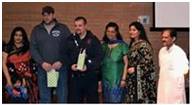 The event had a great start with a warm welcome from Ameeta Ambe followed by singing of the national anthems of both countries representing our love and respect for the country we came from and the nation that has accepted us, granting even citizenship.
The event had a great start with a warm welcome from Ameeta Ambe followed by singing of the national anthems of both countries representing our love and respect for the country we came from and the nation that has accepted us, granting even citizenship.
A short presentation in the program gave the context and purpose of the event, organizations involved and the great need for us to intertwine with the mainstream, and give back to the community something tangible. Organizers felicitated Mr. Ray Costain and Mr. Dan Ruscitto, members of the Carnegie EMS department.
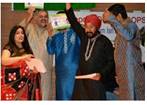 An entertaining Bollywood Jeopardy program led by Pradeep Fulay followed, with a collection of questions based on popular Hindi songs and movie clips. Interesting Jeopardy-like questions followed. A highlight of the evening was a raffle draw ticket at the end. The event had a good balance of excitement, good citizenship, fun, camaraderie, and was a well-run evening program.
An entertaining Bollywood Jeopardy program led by Pradeep Fulay followed, with a collection of questions based on popular Hindi songs and movie clips. Interesting Jeopardy-like questions followed. A highlight of the evening was a raffle draw ticket at the end. The event had a good balance of excitement, good citizenship, fun, camaraderie, and was a well-run evening program.
The event raised slightly over $3000, and was donated to Military Connections, Pittsburgh; Officer Down Memorial, Canonsburg PA; Volunteer Fire and Rescue, Carnegie PA; and Lakshya Foundation, Pune.  ♣
Rally in Mt Lebanon Against Ethnic Violence
Posted by admin in April 2017 on April 2, 2017
By Premlata V.
e-mail:Â ThePatrika@aol.com
Sunday afternoon, 4:30 PM, December 18, 2016. The last shopping Sunday before Christmas. Subfreezing temperatures. The gentle wind made it miserable to be out in the open. But that did not stop several hundred residents of Mt. Lebanon, many with young children, to assemble in the open at the Mt. Lebanon Rec Center in their winter gear. Hot coffee, tea and chocolate served was enough to keep them warm.
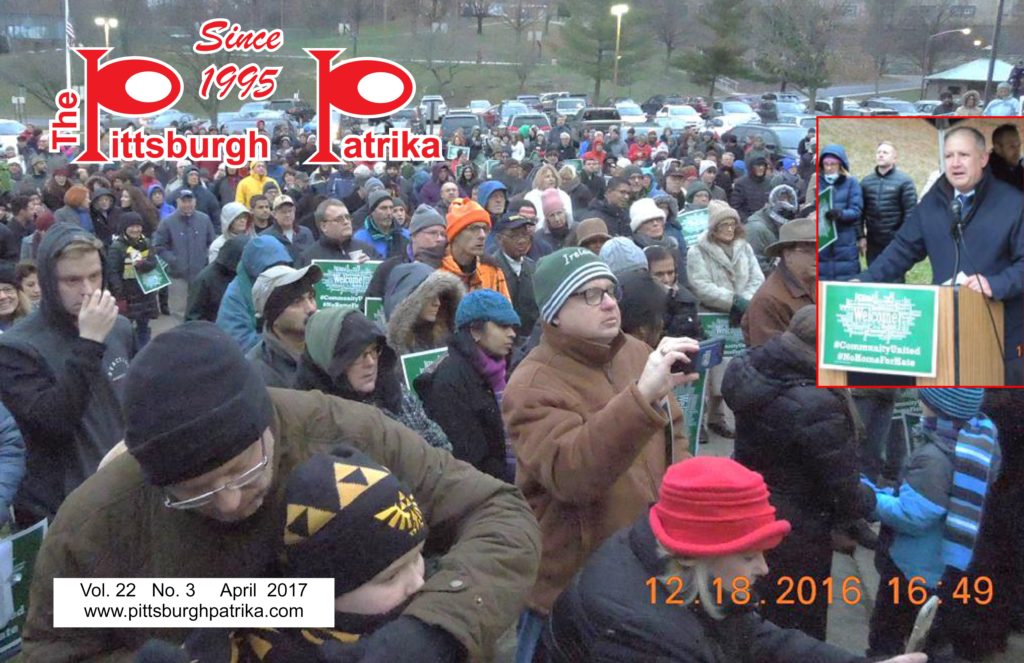
 The cover page for the April 2017 issue.
They assembled in response to Pennsylvania state Rep. Dan Miller’s call for a Rally for Unity to show the community’s response to stray incidents of hate crimes. Addressing the gathering, Miller — he represents the State House District 42 (South Hills) in Harrisburg — said, “While perhaps few in number, the recent spike in identity-based and hate-related incidents have caused many to be concerned. We must come together publicly to reaffirm our shared values and commitment to inclusion. I believe we will send a clear message that actions which make people feel less safe or unwelcome are not reflective of our community, and will not be accepted.â€
That the South Hills community responded so quickly shows that people there took these stray events seriously before they become a pattern. Leaders of the Jewish, Christian and Muslim faiths and representatives of African-Americans and other groups addressed the gathering, echoing Miller’s central message. Not surprisingly, given our apathy, Indian representation on the podium was conspicuous by its absence, even though a large number of professional Indians live in the area.
 Roosha Mandal and Mythri Sundar (see the picture on the side) braved the cold and gave a brief recital of Indian dances, making up for the inexplicable absence of Indians at the podium or in the gathering. Remember, one of the victims of the hate crime there was Ankur Mehta, an Indian-American.
Roosha Mandal and Mythri Sundar (see the picture on the side) braved the cold and gave a brief recital of Indian dances, making up for the inexplicable absence of Indians at the podium or in the gathering. Remember, one of the victims of the hate crime there was Ankur Mehta, an Indian-American.
It was a rare feat to see Indian dancers wearing gloves and ballet shoes to keep them warm. Later, Roosha and Mythri told me,â€It was not easy to do jatis on concrete floor and show mudras with gloves on in freezing temperatures.
A highlight of the event was Pastor Jim Magaw (see the picture) from the Unitarian Universalist Church of the South Hills singing the famous Woody Guthrie song, This land is Our Land, appropriate for the occasion.
Rep. Miller sent a strong message when he declared, “I want people to know that they are welcome in Mt. Lebanon, irrespective of their land of origin, the color of their skin, or where you worship. You are welcome.†It made this immigrant woman who has lived here over 30-plus years feel very welcome and included.    ♣
On Hate Crimes Against Indian-Americans
Posted by admin in April 2017 on April 2, 2017
By Kollengode S Venkataraman
Strikingly, in his very first State of the Union address as President, Donald Trump started the address by condemning the hate crimes committed in the weeks after his ascendancy to the presidency. He singled out the vandalism on Jewish places and generically mentioned the Kansas shooting. These are Trump’s words: “Recent threats targeting Jewish Community Centers and vandalism of Jewish cemeteries, as well as last week’s shooting in Kansas City, remind us that while we may be a Nation divided on policies, we are a country that stands united in condemning hate and evil in all its forms.†Trump’s speech writers did not mention the ethnic background of the Kansas shooting. Here are the details:
Olathe, Kansas. February 22, 2017. Adam Purington, 51, a White man, shot two Indian immigrant engineers, Srinivas Kuchibhotla, 32, and Alok Madasani, also 32, killing the former and wounding the other with gunshots. As he was shooting, witnesses said, he shouted, “Get out of my country.†Purington was a US Navy veteran and a former pilot. Purington also shot another White man, Ian Grillot, who tried to intervene.
The Kansas shooting was not an isolated event. Consider these:
- Last November, soon after the election, Jeffrey Burgess, 54, without any provocation, hurled ethnic slurs and physically assaulted an Indian-American, mistaking him for a Middle Easterner. This happened at a South Hills restaurant. The details were covered in the last issue.
- Lancaster County, South Carolina. March 2, 2017. Harnish Patel, the owner of a convenience store, was shot dead with multiple gunshots right in the front yard of his home late night by an unknown criminal. The County Sheriff’s office said this (as reported in South Carolina’s Post and Courier): “We don’t have any direct evidence that tells us it’s an ethnically motivated killing… … but we are working hard to find out.â€
- Seattle, Washington. March 3, 2017. Deep Rai, a Sikh, was shot in his driveway by an unknown gunman, who was shouting, “Go back to your own country.â€Â Rai prefers to remain anonymous.
Coming in such quick succession in the wake of Donald Trump’s victory last November, hate-crimes based on ethnicity and faith cannot be taken as stray events. After all, during the campaign, candidate Trump’s anti-immigrant rhetoric was shrill, targeting mostly Latinos. Given the economic hardships the less educated, rural and poor Whites face, it does not take long for them to vent their anger on all immigrants who do not look like one of them. People who stand out by their looks (skin tone, color, facial features; or dress codes like yarmulke, turban, etc.); food habits (“ethnic†restaurants, and grocery stores); or faiths (synagogues, mosques, gurudwaras and Hindu temples) become targets.
Educated Indian immigrants in the US and their parents in India see America as the land of freedom, opportunity, reward for hard work and wealth. This is by and large true, particularly in a booming economy as after WW II; or in crisis times (as in the Y2K era). While immigrants’ success stories are widely shared, stories of people who fail for reasons beyond their control are brushed under the carpet.
The other side of the immigrant history is open discrimination and hostility towards immigrants before their assimilation. Blacks were brought centuries ago as slaves against their will. Their assimilation continues to be a work in progress.
Even White immigrants who came later did not have it easy in this Land of the Free. Hostility towards them based on ethnicity (Italians, Slavs, Polish, Irish, etc.) and faith (Jews, Catholics, etc.) is well documented. But the college-educated and anglicized Indian immigrants arriving today seem to have a poor understanding of this immigrant history in the US. They would help themselves by searching the web with phrases like “Historical prejudice towards the Irish,†and then replacing “Irish†with “Italian,†“Slavs,†“Polish,†“Japanese,†“Jews,†“Mormons,†or “Catholics.†What they will see in their search will be a revelation for many.
This will give them a composite picture of the US as “the Land of Freedom, opportunity, wealth, and reward†on the one hand, and a society that is hostile towards new comers on the other; and on the slow, difficult and painful process of getting “mainstreamed.â€Â This is the pattern in the history of the slow assimilation of immigrants in the US.
What should we do and how do we respond to the hate-crimes against us? As we wrote in the last issue, instinctively retracting into our shells out of fear or apathy as a defensive response is the wrong course of action. While we let the law takes its course and deal with the Puringtons, we need to develop contact with local elected and law enforcement officials in the communities where we live. Remember, in emergencies, you call the local 911 or your neighbors for help, not your Congressman in Washington, or your representative in Harrisburg.
If you get an ethnically offensive phone call, or if someone screams racially offensive epithets in parks or shopping malls, first do not get into any argument with the person or persons who provoke you. Report it to your local police. These acts of verbal aggression, when they go unchecked, have the potential to become acts of physical violence. Mayors and law enforcement officials where we live need to know of these incidents for them to take preventive steps to raise awareness in your communities for people to live in peace.
We also need to set our view on a longer, wider horizon. Trying to get the attention of the national media or elected officials in the US Congress in Washington DC or in the state capitol in Harrisburg is what everyone tends to do. However, this is done after the hate crimes are already committed and the damage already done. We need to proactively prevent, or at least reduce, the occurrence of these violent crimes.
An effective way to do this is to be in touch in our individual capacities with local communities where we live, and participate in community events, and be seen by mayors, other city elected officials, police and the people at large as responsive citizens. Yet, most of us do not make it a priority to attend (an easy thing to do) or organize local community events. Don’t wait for your temples to take the lead on this. They won’t. Their priorities are different and they are in their own orbit.
Granted, these activities are not newsworthy enough to draw the attention of local or national TV networks, or your Congressman. But this is our best bet to integrate ourselves into the American mainstream.
Are we paying attention to this part of what we need to do? If the absence of Indian faces in the community event last December in South Hills against ethnic violence is any indication, we don’t seem to see any value in this. See the next article on this.   ♣
On the Recent Jallikattu Protest in Tamil Nadu
Posted by admin in April 2017 on February 7, 2017
By M Meenakshisundaram, Tiruchy, Tamil Nadu, India
e-mail:Â mmsbaskar@yahoo.co.in
Pongal, a harvest festival in Tamil Nadu, usually falls on January 13 or 14. This marks the beginning of the transit of Sun’s northward travel — uttaraayanam. This festival goes by other names, Sankranti, Lowry and others in other parts of India.
The events around this years’ Pongal in Tamil Nadu  is a precursor to what I would call as an event of the century, in any case in the Indian context. These events were around the Jallikattu game, a rural pastoral game deeply rooted in the cultural landscape of agricultural population in the southern part of the Tamil Nadu 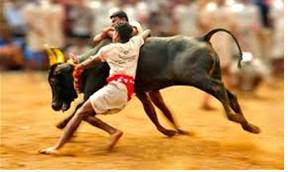 state.  For thousands of years, neutered bulls have been used for tilling the soil. Only in recent decades, mechines are being used for tilling the land. So, cows and bulls have been an integral part of farming in Southern India.  Jallikattu is an old agrarian game with youngsters trying to tame a well-groomed and well-fed bull, traditionally used to mate with cows. Young men show their skills in taming an aggressive bull.  In YouTube, you can see many clips of the Jallikattu game. The bull is not killed or hurt in this contest. But sometimes, not only the bulls, but also the young men trying to tame them, get hurt, even killed. Here is a video clip of the real Jallikattu event.  Evidently, this high-adrenaline game is not for the faint-hearted. Prize money and the chance to display one’s raw courage and skills are strong attractions for young men to participate in this game.
state.  For thousands of years, neutered bulls have been used for tilling the soil. Only in recent decades, mechines are being used for tilling the land. So, cows and bulls have been an integral part of farming in Southern India.  Jallikattu is an old agrarian game with youngsters trying to tame a well-groomed and well-fed bull, traditionally used to mate with cows. Young men show their skills in taming an aggressive bull.  In YouTube, you can see many clips of the Jallikattu game. The bull is not killed or hurt in this contest. But sometimes, not only the bulls, but also the young men trying to tame them, get hurt, even killed. Here is a video clip of the real Jallikattu event.  Evidently, this high-adrenaline game is not for the faint-hearted. Prize money and the chance to display one’s raw courage and skills are strong attractions for young men to participate in this game.
The Jakkikattu Vendum (“We Want Jallikkattu”)Â movement started off in distant Alanganallur, Madurai with about 300 or 400 villagers participating.
The protests happened just after Pongal, when it was clear that there was no possibility for the Jallikattu game to take place. The Indian federal government has banned it a few years ago . There was also a small number of supporters joinrf the Alanganallur crowd, not a sizable crowd at all. The Police, as is their usual wont, arrested the demonstrators when there was no provocation.
The Jakkikattu Vendum (We Want Jallikkattu) Â movement started off in distant Alanganallur, Madurai with about 300 or 400 villagers participating. This happened just after Pongal, when it was clear that there was no possibility at all. There was also a small section of supporters joining the Alanganallur crowd, not a sizable crowd at all. The Police, as is their usual wont, arrested the demonstrators when there was no provocation.
The highhandedness of the police prompted a discussion in the social media with the suggestion that they converge at the Marina, demand scrapping of the ban on Jallikattu and release of the arrested. This was on 17th January, two days after Pongal.
The crowd that gathered at Vivekananda House along the Madras Beach, was a mere 500. However, with the phones in almost everybody’s hand, the social media was abuzz and in a matter of two hours the crowd increased to a few thousands. As the day wore on, more and more converged, and by evening the crowd was around 10,000. The students there then decided not to leave the scene until the ban was revoked and Jallikattu could be held.
The other demand was to release those arrested in Madurai. There was a steady stream of protesters making a beeline to the Marina. The dawn of 18th January saw an outpouring of girls and boys and girls to the spot. The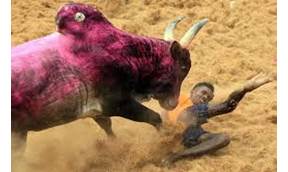 numbers swelled to beyond 50,000 and by that evening it was beyond 75,000. After that there was a deluge. It went beyond counting with a continuous inflow and at no stage there was any sign of the flow stopping. The third day saw homemakers, middle aged and even senior citizens joining the protests. All through this the sense of discipline exhibited by the youngsters was incredibly stunning!
numbers swelled to beyond 50,000 and by that evening it was beyond 75,000. After that there was a deluge. It went beyond counting with a continuous inflow and at no stage there was any sign of the flow stopping. The third day saw homemakers, middle aged and even senior citizens joining the protests. All through this the sense of discipline exhibited by the youngsters was incredibly stunning!
- Have you ever witnessed agitators helping the law-enforcing folks in directing traffic so that the flow is smooth? Have you ever seen agitators, forming rings around the young girls so that they can sleep without danger of any threat from antisocials? Have you ever seen agitators ensuring smooth supply of food packets, tea, coffee to all?
- There were quite a few philanthropists in the crowd and outside as well, who, moved by the sincerity and plight of the youth wholeheartedly pooled in their mite. Ragava Lawrence, a dance master and an actor of sorts, had the presence of mind to provide mobile eco toilets to the girls at the Marina (protest sites all over TN had these toilets).
- Have you ever observed agitators removing all garbage at the site and keep the surroundings clean? Have you ever witnessed parents bringing their daughters to the protest area and leaving them to stay overnight?
- Have you ever seen infants (3, 4, 5 month old) with their mothers using the pallu as a shield from sunlight sitting for 5 , 6, 7 hours on the sands? There were several pregnant women as well.
- Have you ever witnessed an agitation where the numbers were about 300,000 to 400,000 and on some days beyond 700,000, gather peacefully, dignified, without ANY stone throwing, bus burning, arson etc in independent India?
- Have you seen a protest, where in the multitude of people, ambulances were able to pass through quickl the agitators who took extra effort to ensure quick passage?
- Have you ever seen a protest held for seven days where politicians of all colors, were effectively kept away from participating in the agitation. No politician was allowed anywhere near the scene. Even film personalities were not welcome.
- Lastly have you ever read in history any agitation that sprang out of spontaneity, yet had no leader at all?
Well all these happened here at that Marina for six days six nights, back-to-back. But wait! This was not restricted to the Marina. It was so in many second- and third-tier towns such as Trichy, Coimbatore, Madurai, Salem Tirunelveli, Tuticorin, Erode, Tanjore, Vellore, Pondy, Pudukottai, Dharmapuri, Namakkal,Dindigul, Karur, and many others. Not just the cities, it was also held in innumerable villages. Everywhere it was the youth, boys and girls who stayed put day AND night,
This is the stuff of fairy tales and the youngsters were the heroes of this unbelievable Utopian like protest. Tamil heritage took center stage among jeans-clad churidar-wearing youth of TN.
What a heartening exhibition of civic sense, cultured behaviour, and concern for preservation of heritage!
Naturally, the central and state Governments had to oblige. The Chief Minister went to Delhi on Thuirsday night, met the PM on Friday morning, Â stayed back finalised the draft bill, got it vetted by the law, home and environment ministries, obtained president’s consent and caused the ordinance to be issued on Saturday evening. The assembly convened on Monday for its regular opening in the new year, where after the Governor’s customary address, the assembly reconvened and the ordinance bill was passed and it becam a law last evening.
I am sure that this nonviolent protest would have warmed the mahatma’s heart.
I am very very proud to salute the youth here for having conducted what I would term as the best protest in independent India since 1947.   ♣
